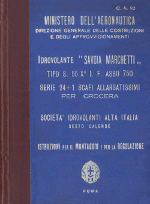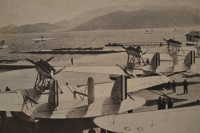 |
 |
 |
 |
 |
 |
 |
 |
 |
||||
The sea planes
The communications
Communications network The ships
Ship Alice The airplanes in support The equipment |
From "La centuria alata" by Italo Balbo: "I will not hesitate to describe the" S 55 ", whose fame has become consolidated throughout the world through legendary exploits.The beautiful device has, however, still been reinforced and refined for the new Cruise: it's all muscle, power and speed: «like an Olympic athlete» writes his brilliant builder Alessandro Marchetti. The fate of the «S 55» is strange. Designed by Marchetti in 1922, in the competition announced by the Air Force Commission for a "seaplane launches torpedoes", it was severely rejected by the Examination Committee with a summary judgment: "it is not considered interesting and does not deserve to reproduce it beyond the first example ». Preventions due to an outdated mentality, which terrified in front of a bold innovation of construction. When, at the end of 1926, I was hired as Under Secretary in the Ministry of Air, I wanted to review that judgment and put the 'S 55' on line. Since that time, the device has given Fascist Italy 15 Atlantic overpasses, among which the one from Italy to Brazil stands out. The X model we use in this cruise is equipped with Isotta Fraschini engines of 1500 horses, can reach a speed of 280 kilometers per hour and is tested for an average speed of 225: with 1000 kilograms of payload can cover a distance over 4000 kilometers with an average consumption of one kilogram per kilometer. The most important innovations refer to the propellers, the radiators, the tanks, the superstructure of the hulls, the profile of the central plane, the fairings between the tail beams and the empennages. For these two years eighty-eight combinations have been experimented with the propellers. Given the preference for metal propellers, the types of foreign houses, Heddena-heimer, Junker, Ratier have been tested. For the tests related to the propellers, 250 experimental flights were made. The victory remained at the propeller of S. I. A. I. with three blades, which, at the same maximum speed and minimum consumption, provides greater traction for the take-off. Eighteen types of radiators have been tested: the final one has an annular shape, with rectangular tubes, and has been mounted in front of the front engine. It too is Italian and manufactured by S. I. A. I. It is known that the disadvantages of the previous Cruise almost all of them were due to radiators. The type chosen for the new Atlantic company has the old requirements for cooling, but it is less heavy and more resistant to the torment of vibrations. Also the octagonal section tanks that we used in the Italy-Brazil raid could not be adopted for the Decennial Cruise which requires an increase in capacity and a better seal guarantee: they were then replaced with oval and cylindrical capacity tanks and superior robustness: the vibratory bench has experienced them for the duration of fifty hours: the static and dynamic tests have been carried out with a pressure higher than thirty meters of water. The other modifications have had for goal a greater aerodynamic refinement, which has no comparison now with the previous apparatus. "
Following some images; click to enlarge
| |||||||||||

















